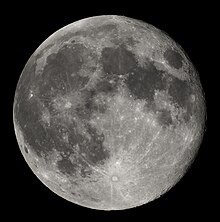Ый
Тас көрүҥэ
 Сиртэн көстөр Ый туолуута |
||||||||||
Designations
| ||||||||||
|---|---|---|---|---|---|---|---|---|---|---|
| Adjective | "lunar" | |||||||||
Эргийэр иитэ
| ||||||||||
| Perigee | 363 104 km (0.002 4 AU) | |||||||||
| Apogee | 405 696 km (0.002 7 AU) | |||||||||
| Semi-major axis | 384 399 km (0.002 57 AU[1]) | |||||||||
| Eccentricity | 0.054 9[1] | |||||||||
| Orbital period | 27.321 582 d (27 d 7 h 43.1 min[1]) | |||||||||
| Synodic period | 29.530 588 d (29 d 12 h 44.0 min) | |||||||||
| Average orbital speed | 1.022 km/s | |||||||||
| Inclination | 5.145° to the ecliptic[1] (between 18.29° and 28.58° to Earth's equator) |
|||||||||
| Longitude of ascending node | regressing by one revolution in 18.6 years | |||||||||
| Argument of perigee | progressing by one revolution in 8.85 years | |||||||||
| Satellite of | Earth | |||||||||
Физика кээмэйдэрэ
| ||||||||||
| Mean radius | 1 737.10 km (0.273 Earths)[1] | |||||||||
| Equatorial radius | 1 738.14 km (0.273 Earths) | |||||||||
| Polar radius | 1 735.97 km (0.273 Earths) | |||||||||
| Flattening | 0.001 25 | |||||||||
| Circumference | 10 921 km (equatorial) | |||||||||
| Surface area | 3.793Халыып:Esp km² (0.074 Earths) | |||||||||
| Volume | 2.195 8Халыып:Esp km³ (0.020 Earths) | |||||||||
| Mass | 7.347 7Халыып:Esp kg (0.012 3 Earths[1]) | |||||||||
| Mean density | 3 346.4 kg/m³[1] | |||||||||
| Equatorial surface gravity | 1.622 m/s² (0.165 4 g) | |||||||||
| Escape velocity | 2.38 km/s | |||||||||
| Sidereal rotation period |
27.321 582 d (synchronous) | |||||||||
| Equatorial rotation velocity | 4.627 m/s | |||||||||
| Axial tilt | 1.542 4° (to ecliptic) 6.687° (to orbit plane) |
|||||||||
| Albedo | 0.12 | |||||||||
| Surface temp. equator 85°N[5] |
| |||||||||
| Apparent magnitude | −2.5 to −12.9[2] −12.74 (mean full moon)[3] |
|||||||||
| Angular diameter | 29.3 to 34.1 arcminutes[3][4] | |||||||||
Ый диэн Сир соҕотох уонна Күн систематын улаханынан бэhис аргыhа.
Быһаарыылар
[уларыт | биики-тиэкиһи уларытыы]- ↑ 1,0 1,1 1,2 1,3 1,4 1,5 1,6 Цитата сыыһата: Сыыһа
<ref>тиэк (тег);W06диэн хос быһаарыыларга аналлаах тиэкис суох - ↑ The maximum value is given based on scaling of the brightness from the value of -12.74 given for an equator to Moon-centre distance of 378 000 km in the NASA factsheet reference to the minimum Earth-Moon distance given there, after the latter is corrected for the Earth's equatorial radius of 6 378 km, giving 350 600 km. The minimum value (for a distant new moon) is based on a similar scaling using the maximum Earth-Moon distance of 407 000 km (given in the factsheet) and by calculating the brightness of the earthshine onto such a new moon. The brightness of the earthshine is [ Earth albedo × (Earth radius / Radius of Moon's orbit)² ] relative to the direct solar illumination that occurs for a full moon. ({{{1}}}; {{{1}}} radius × equatorial {{{1}}}).
- ↑ 3,0 3,1 Williams, D.R. Moon Fact Sheet. NASA (February 10, 2006). Тургутулунна 12 Алтынньы 2007.
- ↑ The range of angular size values given are based on simple scaling of the following values given in the fact sheet reference: at an Earth-equator to Moon-centre distance of 378 000 km, the angular size is 1896 arcseconds. The same fact sheet gives extreme Earth-Moon distances of 407 000 km and 357 000 km. For the maximum angular size, the minimum distance has to be corrected for the Earth's equatorial radius of 6 378 km, giving 350 600 km.
- ↑ A.R. Vasavada, D.A. Paige, and S.E. Wood (1999). «Near-Surface Temperatures on Mercury and the Moon and the Stability of Polar Ice Deposits». Icarus 141: 179. DOI:10.1006/icar.1999.6175.
| ||||||||||||||

